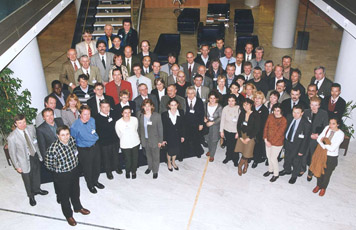Draft Agenda for theThird Meeting of the Task Force on Measurement and Modelling

Tuesday 19 March 2002
Joint session TFMM and EIONET
14:00 - 14:05 Opening meeting (Deputy Secretary-General WMO)
14:05 Introduction (Chair TFMM)
14:05 Adoption of the agenda
14:05 - 14:15 News from the CLRTAP (Henning Wüster)
Streamlining of Reporting
- Evaluation of using the DEM
- Shift to new reporting scheme
14:15 - 14:25 Reporting to EIONET (Frank de Leeuw)
14:25 - 14:35 Reporting to EMEP (Kjetil Torseth)
14:35 - 14:45 Discussion
CAFE
14:45 - 15:15 Recent developments in CAFE (Marion Wichmann-Fiebig)
15:15 - 15:30 Discussion
15:30 - 16:00 Coffee Break
The weekend effect:
16:00 - 16:20 Examples from Germany (Wolfgang Bräuniger)
16:20 - 16:40 Assessment of EIONET data (Roel van Aalst)
16:40 - 17:00 Discussion
18:00 Reception hosted by WMO (Salle D, Attique)
Wednesday 20 March 2002
PM: Joint session TFMM and EIONET
9:00 - 9:20 PM measurements in EIONET (Roel van Aalst)
9:20 - 9:40 Current
implementation of the EMEP PM strategy (Kjetil
Tørseth, CCC)
9:40 - 10:00 PM10 manual - adoption (Michael Kahnert)
10:00 - 10:30 Chemical speciation of PM, EC/OC campaign (Christian Dye,
CCC)
10:30 - 10:50 Coffee Break
10:50 - 11:10 Conclusions from the NMR workshop on PM modelling (Anton Elisassen)
11:10 - 11:30 Discussion, conclusions
11:30 End of joint session
Assessment Report
11:30 - 11:50 Organisational structure of the assessment report (Anton Elisassen)
11:50 - 12:20 Outline of the Assessment report (Gun Lövblad)
12:20 - 14:00 Lunch break
14:00 - 14:30 Quality assurance and data quality in relation to trend assessments in EMEP (K. Torseth, CCC)
14:30 - 15:00 Supporting data for interpretation of trends available at the EMEP website (Anna Benedictow, MSC_W)
15:00 - 15:10 Possible contributions to the assessment report on HMs and POPs (S. Dutchak, MCS-E)
15:10 - 15:40 Assessment of Lagrangian model performance (S. Vidic)
15:40 - 16:10 A preliminary look at alternative analyses of trends in EMEP measured concentrations (R. Smith)
16:10 - 16:30 Coffee break
16:30 - 16:50 Trend analyses of air quality monitoring data using Mann-Kendall tests (T. Salmi)
16:50 - 17:20 Ozone trends (M. Roemer, TNO)
17:20 - 18:00 Discussion, summary and outlook
Thursday 21st March
Transposition from Lagrangian to Eulerian modelling: consequences for the EMEP monitoring strategy
9:00 - 9:30 Evaluation of differences in source-receptor relationships (Anton Eliassen, MSC_W)
9:30 - 9:50 The CHIMERE model: Comparisons of modelled data with measurements (Laurence ROUIL)
9:50 - 10:20 Changes in the monitoring strategy for EMEP (Kjetil Torseth, CCC)
10:20 - 11:00 Coffee Break
11:00 - 12:15 Discussion: TFMMs revision of the transposition to Eulerian models and recommendations on the necessary changes in model validation, interpretation tools and monitoring strategy.
12:15 - 14:00 Lunch break
Monitoring and Modelling of Persistent Organic Compounds
14:00 - 14:10 Introduction (S. Dutchak, MSC-E)
14:10 - 14:30 Measurements of POPs (K. Breivik, CCC)
14:30 - 14:50 Progress and problems of POP modelling (V.Shatalov, MSC-E)
National presentations
14.50 - 15.05 Investigating the global fate of POPs with the multi-media box models "ChemRange" and "CliMoChem" (M. Scheringer, Switzerland)
15.05 - 15.20 Modelling Dioxins from North America to the Arctic: determining source to receptor relationships (P. W. Bartlett, USA)
15.20 - 15.35 Observations on the global cycling and modelling of POPs (K.Jones, UK)
15.35 - 15.50 Assessing long range transport potential and overall persistence by using multimedia model (M. Matthies, Germany)
15.50 - 16.05 Coffee break
16.05 - 16.20 The assessment of long -range transport influence to the regional air pollution by total particulate hydrocarbons, benzo(a)pyrene and soot (A.R.Milukaite, Lithuania)
16.20 - 16.35 Integrated monitoring of POPs - the comparison of the contamination on the regional and local levels. (I.Holoubek, the Czech Republic)
16:35 - 16:50 Trends in POP concentration and fluxes other Northern Europe (Eva Brorstroem)
16:50 - 17:30 Future
activity (MSC-E, CCC):
POP model intercomparison study,
co-operation with national experts, international programmes and
ad hoc expert group on POPs (new substances),
17:30 - 18.00 Discussion, conclusions and recommendations.
Friday 22nd March
9:00 - 9:10 Ozone concentration gradients in the EMEP model (A. Eliassen)
9:10 - 9:20 Ozone trends in the Mediterranean (M. Milan)
Ammonia Session (to be confirmed)
9:20 - 9:40 Modelling of reduced nitrogen in the UK (T. Dore)
9:20 - 9:50 Ammonia - monitoring data from UK (M. Sutton)
9:50 - 10:10 Reduced nitrogen: Emissions, modelling and measurements in Switzerland (R. Ballaman)
10:10 - 10:30 Discussion
Other issues
10:30 - 11:30 Work plan for 2002 - 2004: the role of TFMM
11:30 - 13:30 Lunch break
13:30 - 14:20 Report to the EMEP Steering Body
14:20 - 14:30 Any other business
End of Meeting